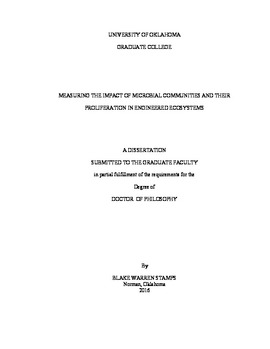| dc.description.abstract | The interactions between humans, the structures we build, and the microorganisms that inhabit these spaces are inescapable. Engineered ecosystems are classified broadly as any ecosystem built or managed by humans. Buildings and other infrastructure may corrode and fail as a result of microbial metabolism. Microbial fouling directly impacts fuel and water distribution systems. Microorganisms inhabiting surfaces in engineered ecosystems may also impact human health. Three engineered ecosystems; landfills, biodiesel storage tanks, and aircraft, were characterized as a part of this dissertation using a combination of small subunit ribosomal RNA sequencing, in situ measurements of microbial activity, cultivation, and laboratory experimentation. Landfills are one end point for the waste produced by humans and are of increasing concern due to the presence of chemicals of emerging concern. In order to better understand the role of microorganisms on the life cycle of landfills, it is important to characterize the microorganisms that inhabit landfill leachate and if the unique geochemical landscape of leachate impacts the microbial community composition. Landfill leachate microbiomes are distinct from many other engineered or natural ecosystems, possibly due to a combination of chemical and geographic parameters at each landfill.
One drawback of the landfill leachate study was a lack of sampling events over time and our ability to cultivate microorganisms that may directly impact the operation of an engineered ecosystem. In collaboration with the United States Air Force (USAF) and the Air Force Research Laboratory, we investigated the extent of fuel fouling and material corrosion within B20 biodiesel storage systems at multiple USAF facilities over an eighteen-month survey. Bacterial and fungal communities were largely distinct at each sampled location although the abundant members of the fungal community were found at many sampled tanks. The risk to infrastructure through generalized corrosion was low; however, pitting corrosion was increased when associated with fungal biomass. The filamentous fungi found in underground storage tanks have the ability to degrade components of the fuel and increase the corrosion of metals, representing a risk to infrastructure. Information gathered in the in situ studies and laboratory experimentation described in this dissertation could help operators detect and assess the likelihood of biofouling and corrosion in B20 biodiesel blends.
In many engineered ecosystems, including B20 underground storage tanks, the removal or mitigation of microorganisms is desirable. An opportunity arose to test the impact on the microbiome of a C-130H aircraft using a novel means of whole-aircraft decontamination. After 72 hours of decontamination with hot, humid air, the bacterial, archaeal, and eukaryotic community structure was significantly altered. Fewer viable microorganisms were cultivable after decontamination. The use of hot, humid air decontamination appears to be a viable method of decontaminating an entire aircraft. The use of hot, humid air may also be useful in other engineered ecosystems such as the B20 biodiesel storage tanks that contain undesired microorganisms. By using a combination of techniques that compliment one another, we have identified and isolated abundant members of the bacterial and fungal community that contaminate USAF B20, the risk they pose to infrastructure, and a potential means to controlling microbial communities in engineered ecosystems. | en_US |
